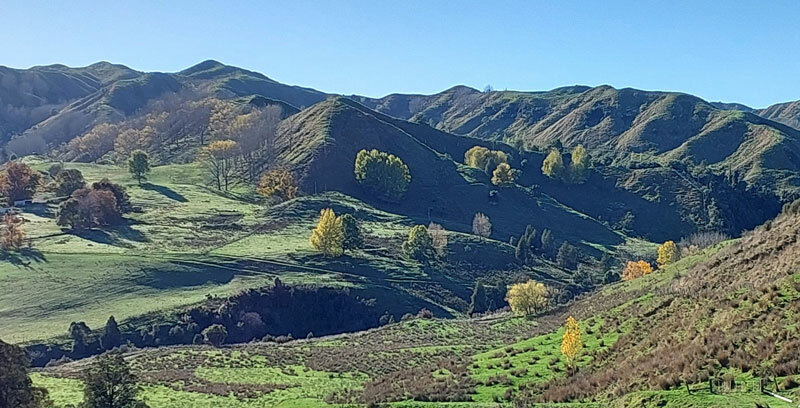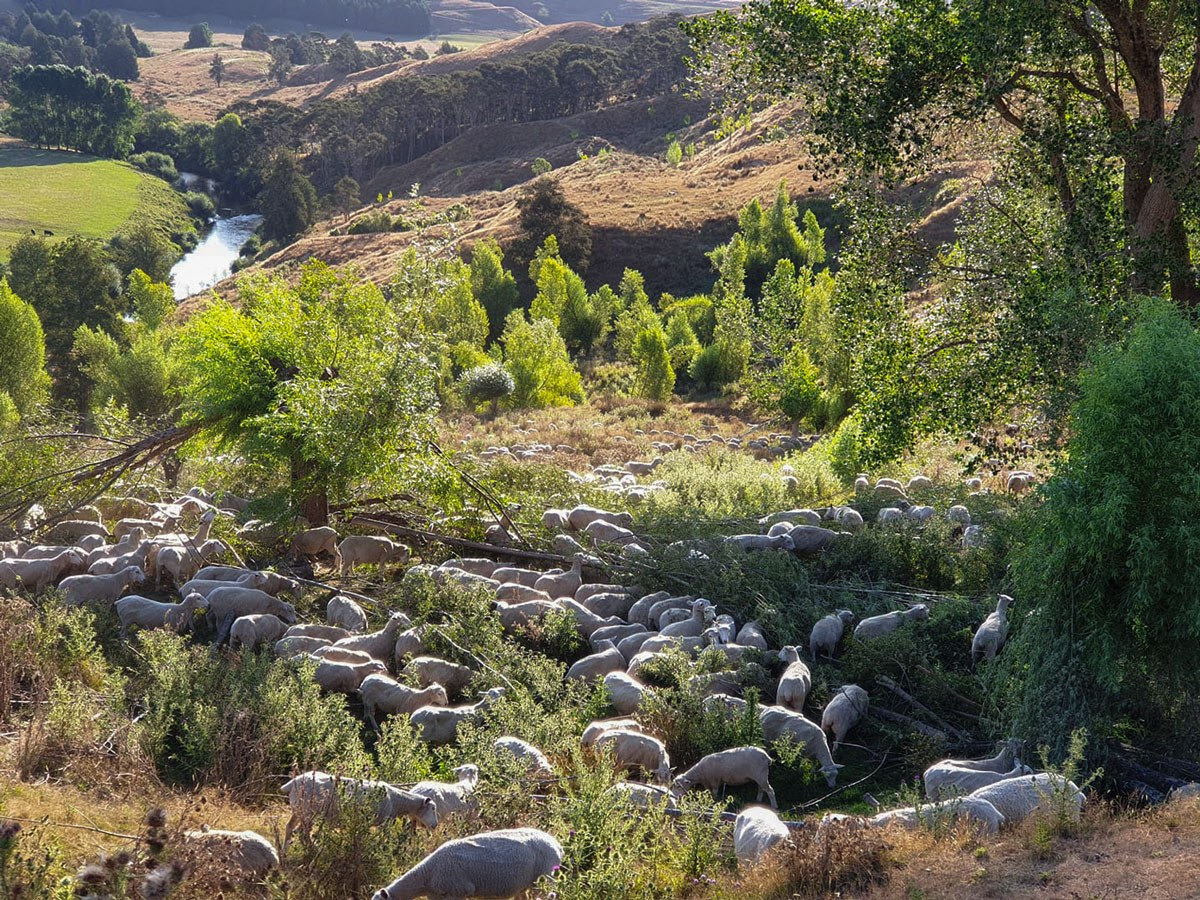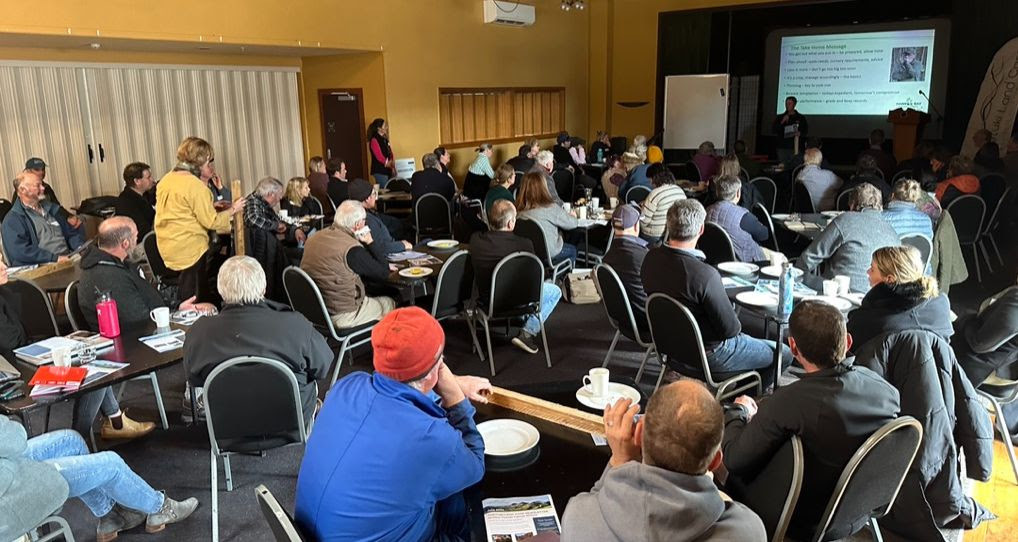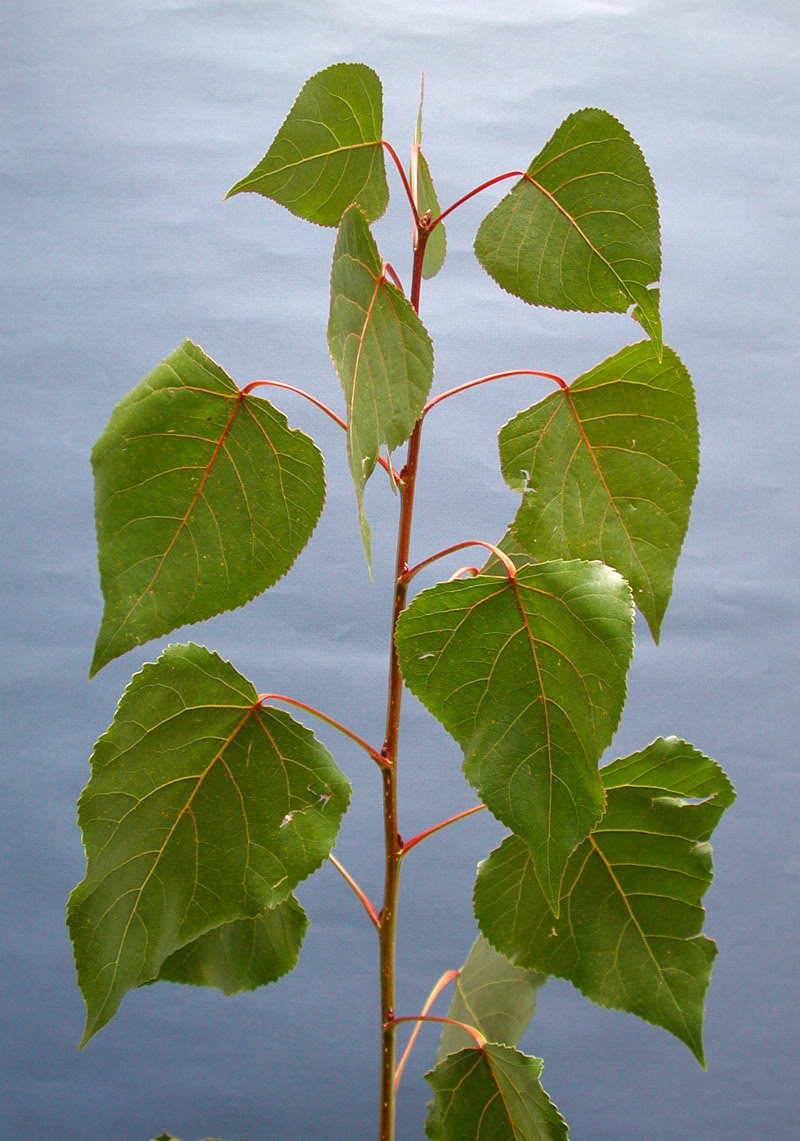Newsletter No. 3 August 2024
Posted on August 21, 2024

Gorgeous sunny day here in the Manawatu after a treacherous week around the country - snow, wind and rain. Lambs popping up everywhere and lots of action has been had in and around pole planting. Please feel free to pass on the newsletter to colleagues and friends to enjoy also. Contact info@poplarandwillow.org.nz to join the mailing list.
Meet Iain Maxwell, Trust chairperson

Iain is the Integrated Catchment Management Group Manager at Hawke’s Bay Regional Council, which covers environmental science, environmental information, sustainable land management, biodiversity and biosecurity. Iain was appointed as the Trust Chairperson at the AGM in 2021 by the Regional Council CEOs.
Iain has been working in the resource management system for over 30 years. Before joining the Hawke’s Bay Regional Council in 2011, he worked with Cawthron Institute as a Senior Freshwater Ecologist, Fish and Game New Zealand as a Regional Manager, and with the Department of Conservation.
While working for HBRC, Iain has worked at a national and regional level supporting the development of policy development and implementation, biosecurity management, and science programmes. After convening the Resource Managers Group, he now convenes the Science Advisory Group (includes governance of the Envirolink programme) and BioManagers Group for regional councils.
Catchment Management Practices
Comparing poplar and willows with natives
Woody vegetation, notably willows and poplars, has been a low cost tool in catchment engineering for the management of high water flows, reduction in sediment transfer and protection of watercourse banks. Poplars and willows have been used historically as tools in catchment management for very sound reasons. Poplars and willows are still considered the best bioengineering tools in catchment management, primarily because of their superior rooting capability, adaptability and ease of management.
How do root systems of poplar and willow compare with other species?
Eleven woody native plant species were grown from young potted plants in a silt loam soil for five years and measurements were made of above and below ground growth annually (Marden et al. 2025). Marden et al. (2005) reported that for all native species tested, their root systems were typically shallow and confined to the uppermost 31 cm of soil. Root spread (mean maximum diameter) increased with increasing age with interspecies differences, by age 5 years, ranging from ~1 and 2.5 m (Figure 1). At age 5 years the mean root biomass (Figure 2) ranged from 0.1 - 3 kg and for all species combined, was 1.2 kg/plant, averaging ~23% of total plant biomass.
In comparison, the measurement of one season’s growth root biomass for willows and poplars ranged between 2 and 8 kg (Table 1), root length was measure in 00’s of m (Table 1) and root spread ranged between 4.8 m - 11.1 m (Figure 1).
Therefore the root parameters after one season’s growth for willow and poplar, were more than double the sizes achieved by the native species after five years.

Figure 1: Root spread (mean maximum diameter) of selected native colonising species after 5 years growth in an alluvial terrace soil in Gisborne, together with root spread of poplar and willow (mean of all planting material types see table 1) after 1 year’s growth at the same site (data from Marden et al. 2005 and Phillips et al. 2014).

Figure 2: Above and below ground biomass of selected native colonising species after 5 years growth in an alluvial soil in Gisborne together with the above and below ground biomass of poplar and willow (mean of all planting material types see Table 1) after 1 year’s growth at the same site (data from Marden et al. 2005 and Phillips et al. 2014).

Table 1: Shoot and root biomass for willow and poplar planting types after one season’s growth (n = 1 tree only; trees grown at the same site and in the same soil at Gisborne as the native species in Figures 1 and 2). (from Phillips et al. 2014).
Conclusion
Results of these trials strongly indicate that the right tree in the right place for the right purpose is important. In areas where there is a high erosion risk (riverbank, gully or pastoral), the use of poplar and willows appears to be favoured. Natives tend to suit watercourses where there is a lower risk of erosion. In larger river systems, there is better survival of natives behind the front row defense of willows where they are protected from flooded river systems and risk damage from rocks and debris. Many natives appear to struggle in the drier, stony river, and do better on the alluvial areas.
Poplar and willows can also be used as a nurse crop, to then plant and grow natives underneath.
Native plants tend to be slower growing, more costly to establish, need higher levels of maintenance to get the best performance/survival, are generally more shallow rooted, and are effective for bank protection in small streams (less than several metres wide) and if bank heights are less than about 1-2 meters.
In contrast, poplar and willows are fast growing, cost-effective to establish, limited maintenance for survival, deep and expansive root systems, and able to withstand flooding.
References
Marden, M.; Rowan, D and Phillips, CJ. 2005: Stabilising characteristics of New Zealand indigenous riparian colonising plants. Plant and Soil 278: 95-105
Phiilips, CJ, Marden, M and Lambie SM 2014: Observations of root growth of young poplar and willow planting types. New Zealand Journal of Forestry Science 2014 44:15
Poplar and Willow as Livestock Feed
Peter Kemp, Massey University Trustee
A side benefit of poplar and willow trees planted for erosion or riparian management is the fodder value of their vegetation. Research has shown that the edible fodder from the trees has a higher nutritive value than dryland summer pastures. Edible fodder is defined as the leaves plus the stems up to 5mm in diameter. Though cattle can eat thicker stems when pushed the nutritive value of the stems is low.
In summer the edible fodder of both tree species has a nutritive value more than adequate for the maintenance of livestock. The table shows measured values for organic matter digestibility of poplar and willow compare well with regular (55 – 65%) and dry (52 – 55%) hill pasture. Crude protein concentration of edible fodder of both species is 16.5 – 21.0 %. The condensed tannins in both poplar and willow increase protein utilisation by sheep and cattle which adds to the value of the trees as supplementary fodder.
Table 2. The average organic matter digestibility and estimated metabolisable energy for the edible components of nine poplar and three willow cultivars in summer.
| Species | Digestibility(%) | Metabolisable Energy(MJ/kg) |
|---|---|---|
| Poplar | ||
| Edible fodder | 67 | 9.9 |
| Green leaves | 76 | 11.3 |
| Fallen leaves | 50 | 7.4 |
| Bark | 56 | 9.0 |
| Willow | ||
| Edible fodder | 65 | 9.8 |
| Green leaves | 77 | 11.9 |
| Bark | 63 | 9.6 |
So, if you need to thin, coppice or prune the lower branches of your poplar and willow trees then doing it in summer, especially dry summers, provides useful supplementary fodder.
Further reading
Kemp, P.D. 2001. Poplars and willows as fodder trees. Tairawhiti Conservation Quorum 23: 1,8-9.
Kemp, P.D.; Mackay, A.D.; Matheson, L.A.; Timmins, T.E. 2001. The forage value of poplars and willows. Proceedings of the New Zealand Grassland Association 63:115-119.
Kemp, P.D.; Barry, T.N.; Douglas, G.B. 2003.Edible forage yield and nutritive value of poplar and willow. Using Trees on Farms. Proceedings of a Workshop organised by NZ Grassland Association and NZ Farm Forestry Association(Grassland Research and Practice Series No. 10) 53-63.
McWilliam, E.L.; Barry, T.N.; Lopez-Villalobos, N.; Cameron, P.N.; Kemp, P.D.; Cameron, D.J. 2003. Reproductive performance from feeding tree fodder to ewes grazing drought pasture during mating. Using Trees on Farms. Proceedings of a Workshop organised by NZ Grassland Association and NZ Farm Forestry Association (Grassland Research and Practice Series No. 10) 23-34.

Photo: Sheep fodder in King Country (photo credit - Anna Nelson)
Research Programme Update
The latest research progress report focuses on:
- Willow and poplar breeding crosses in 2023
- The performance of young field trials of Salix alba x lasiandra and S. matsudana x lasiandra clones in the Wairarapa and on the Hutt River.
The S. matsudana x lasiandra tree willow clones struggled on a dry Wairarapa hill country farm, but grew well with access to groundwater on the Hutt River. S. alba x lasiandra clone performed well on the dry hill country, with similar survival and growth to ‘Moutere’. - The performance of S. lasiandra x Pentandra, and S. lasiolepis hybrid clones on the Ashburton River, Canterbury.
The S. lasiolepis hybrid shrub willow clones performed well on the banks of the Ashburton River, showing good growth and some drought tolerance on the stony sand soils. The S. lasiandra x pentandra tree willow clones lacked vigour, and appeared to be better suited to higher rainfall sites. - An older field trial of new Populus deltoides x maximowiczii and P. maximowiczii x nigra clones in the Manawatu
These performed well on a Manawatu hill country farm, with good growth and improved stem form, compared with the commercial ‘Eridano’ clone. They could be suitable for commercial use in soil conservation and plantations for timber production, as an alternative to the commercial clone ‘Kawa’, a favoured poplar clone for timber production. - Tree growth and wood density of poplar clones in the Aspendale arboretum near Levin.
The poplar clones at Allan Wilkinson’s Aspendale arboretum showed excellent growth on the peat soils, with the P. ciliata ‘Kulu’, some of the P. deltoides and P. deltoides x nigra clones, and the P. angustifolia x yunnanensis ‘Plummer’ clone performing well. The wood density varied widely, with some of the poplar clones having good growth and moderate to high wood density similar to that of the ‘Kawa’ clone.
Great turn out at the Tukituki Landcare Catchment Group day in July - ‘Making Poplars Popular’
We were thrilled by the fantastic turnout at our recent poplar pole workshop in Waipawa! A big thank you to the 80 attendees who joined us to learn about growing and planting poplars, and their significance in the Emissions Trading Scheme.
It was great to see so many farmers set aside time from their busy schedules to attend and many of you have reached out since the event to share how much you enjoyed it. Richard Hilson, Chair of TLC, shared, “It was a huge turnout and a genuine community event, lots of people catching up, sharing the work and enjoying the project”.
We had some pretty awesome prizes up for grabs including two custom-made pole rammers and attendees also had the opportunity to take home some poplar fence battens, recently milled as part of a TLC-funded project investigating the economics of milling poplar timber.
Special thanks to poplar expert Colin Stace from Hawke's Bay Regional Council for his informative sessions on setting up an on-farm poplar pole nursery, how to grow the very best poplars and how to choose from the huge variety available. Sam Mender from Agri Intel also did a fantastic job discussing carbon credits and the Emissions Trading Scheme. For those who couldn’t attend, the slides from these presentations will be available on our website next week.
We also want to express our gratitude to our panel of farmers - Tim Forde, Claire McCormick, and Mark Warren - for sharing their valuable experiences with growing poplars on their farms. The lively debates and insights were both educational and entertaining.
Thank you all for making this event a success!

Showcasing … Veronese (poplar)
‘Veronese’ (PN 870) is an imported P. euramericana hybrid poplar that was bred in Italy, imported into New Zealand and released commercially in 1986 (P. deltoides x nigra).
It has dark green leaves on the upper surface and light green below with a red midrib. The leaves hang at a vertical angle to the stem.

‘Veronese’ has a narrow crown and excellent apical dominance. It is used for soil conservation, windbreaks, stock fodder and timber production. It is prone to producing epicormic branches when pruned. ‘Veronese’ is very responsive to water stress, dropping leaves to avoid transpiration losses, and is therefore relatively drought tolerant compared with other poplars. It is commonly used on windy and exposed sites.
It is not very resistant to the poplar rust or leaf anthracnose, therefore more suitable to drier sites. It is not possum resistant.

Workshops coming to a place near you…
We are currently working on a number of workshops coming your way.
Understanding Poplar and Willow Workshops inconjunction with NZARM, focusing on land management. For more information contact info@poplarandwillow.org.nz. Tentative dates and locations are:
- 4-5 March - BOP
- 18-19 March - Gore
- 2-3 April - Stratford
Poplars and Willows as Bioengineering Tools focusing on river management. If interested check out Resilient River development programme and register. Dates and locations are:
- 3-4 December - Christchurch
- 11-12 February - Hawke’s Bay
Information on these will be updated here or on LinkedIn.